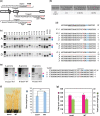Introduction of a second "Green Revolution" mutation into wheat via in planta CRISPR/Cas9 delivery
- PMID: 34908145
- PMCID: PMC8968346
- DOI: 10.1093/plphys/kiab570
Introduction of a second "Green Revolution" mutation into wheat via in planta CRISPR/Cas9 delivery
Abstract
Direct delivery of CRISPR/Cas9 ribonucleoproteins into the shoot apical meristem via particle bombardment enabled introduction of a semidwarf1-orthologous mutation into an elite wheat variety.
Figures


Similar articles
-
Efficient multiplex genome editing by CRISPR/Cas9 in common wheat.Plant Biotechnol J. 2021 Mar;19(3):427-429. doi: 10.1111/pbi.13508. Epub 2020 Nov 30. Plant Biotechnol J. 2021. PMID: 33150679 Free PMC article. No abstract available.
-
Biolistic Delivery of Programmable Nuclease (CRISPR/Cas9) in Bread Wheat.Methods Mol Biol. 2020;2124:309-329. doi: 10.1007/978-1-0716-0356-7_17. Methods Mol Biol. 2020. PMID: 32277462
-
Highly Efficient and Heritable Targeted Mutagenesis in Wheat via the Agrobacterium tumefaciens-Mediated CRISPR/Cas9 System.Int J Mol Sci. 2019 Aug 30;20(17):4257. doi: 10.3390/ijms20174257. Int J Mol Sci. 2019. PMID: 31480315 Free PMC article.
-
Genome Editing with CRISPR-Cas9: Can It Get Any Better?J Genet Genomics. 2016 May 20;43(5):239-50. doi: 10.1016/j.jgg.2016.04.008. Epub 2016 Apr 24. J Genet Genomics. 2016. PMID: 27210042 Free PMC article. Review.
-
[Advances of Cas9/sgRNA delivery system for gene editing].Sheng Wu Gong Cheng Xue Bao. 2021 Nov 25;37(11):3880-3889. doi: 10.13345/j.cjb.210040. Sheng Wu Gong Cheng Xue Bao. 2021. PMID: 34841792 Review. Chinese.
Cited by
-
Redirecting barley breeding for grass production through genome editing of Photoperiod-H1.Plant Physiol. 2024 Apr 30;195(1):287-290. doi: 10.1093/plphys/kiae075. Plant Physiol. 2024. PMID: 38366881 Free PMC article.
-
CRISPR-edited plants by grafting.Nat Biotechnol. 2023 Jul;41(7):909-910. doi: 10.1038/s41587-022-01516-7. Nat Biotechnol. 2023. PMID: 36593416 No abstract available.
-
Advancements in Plant Gene Editing Technology: From Construct Design to Enhanced Transformation Efficiency.Biotechnol J. 2024 Dec;19(12):e202400457. doi: 10.1002/biot.202400457. Biotechnol J. 2024. PMID: 39692063 Free PMC article. Review.
-
Genomic variation in weedy and cultivated broomcorn millet accessions uncovers the genetic architecture of agronomic traits.Nat Genet. 2024 May;56(5):1006-1017. doi: 10.1038/s41588-024-01718-6. Epub 2024 Apr 24. Nat Genet. 2024. PMID: 38658793
-
Plant breeding advancements with "CRISPR-Cas" genome editing technologies will assist future food security.Front Plant Sci. 2023 Mar 13;14:1133036. doi: 10.3389/fpls.2023.1133036. eCollection 2023. Front Plant Sci. 2023. PMID: 36993865 Free PMC article. Review.
References
-
- Hedden P (2003) The genes of the Green Revolution. Trends Genet 19: 5–9 - PubMed
Publication types
MeSH terms
Substances
LinkOut - more resources
Full Text Sources

